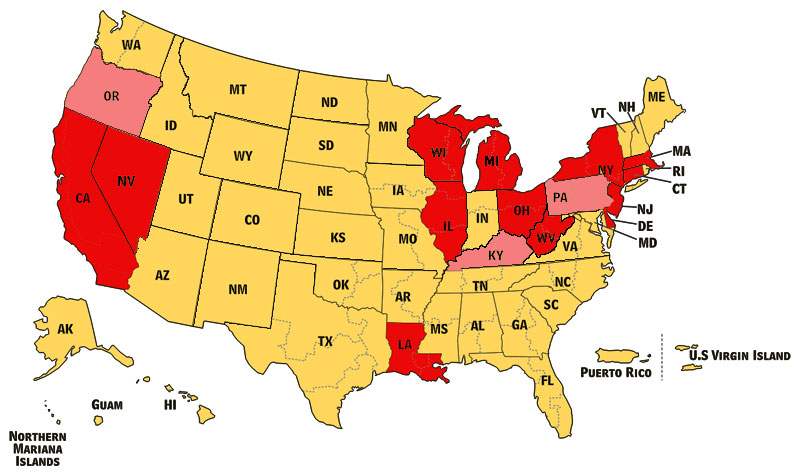Stay-at-home orders issued in more than a dozen states
As COVID-19 continues to spread, several states are taking unprecedented measures to contain it, including statewide stay-at-home orders.
So far, more than a dozen governors have issued some form of a stay-at-home order. While some orders only allow essential workers to leave home for nonessential activities, other orders are less restrictive.
Keep in mind, some municipalities and counties have implemented orders that are more stringent than the state’s.
Stay-at-home orders for all nonessential workers
As of publication, 14 states have issued stay-at-home orders that affect all nonessential workers. Although individual executive orders may differ slightly, the overarching effect is mostly the same.
In California, Executive Order N-33-20 orders “all individuals living in the state of California to stay home or at their place of residence except as needed to maintain continuity of operations of the federal critical infrastructure sectors.” A list of essential employees can be found here. The order stays in effect until further notice. Details can be found here.
Connecticut’s Executive Order No. 7H directs all non-essential businesses and not-for-profit entities in Connecticut to prohibit all in-person functions through April 22. The state is using the U.S. Cybersecurity and Infrastructure Security Agency’s critical infrastructure sectors list to determine which employers are considered essential.
Any business may receive essential status after requesting an opinion from the Department of Economic and Community Development, which will review and grant such requests. Details about Connecticut’s order can be found here.
The fifth modification of Delaware Gov.John Carney’s state of emergency declaration orders all nonessential businesses in Delaware to remain closed from March 24 through May 15 or until the public health threat of COVID-19 has been eliminated. The state’s list of essential and nonessential businesses is listed here. Explanation of the order is posted here.
Illinois Gov. J.B. Pritzker signed Executive Order 2020-10, a stay-at-home order that includes strict travel restrictions for the state’s residents.
Unlike other shutdown orders, the Illinois order prohibits all travel, including travel by automobile, motorcycle, scooter, bicycle, train, plane and public transit. Exceptions to essential travel and essential activities.
Click here for the Illinois coronavirus response site.
Meanwhile in Louisiana, Proclamation 33 JBE 2020 issues a stay-at-home order for nonessential business and activities, including prohibiting gathering of 10 or more people. Click here for the state’s essential infrastructure fact sheet. Details about the order for residents and businesses can be found here.
COVID-19 Order No. 13 in Massachusetts issues a stay-at-home order for all nonessential employees until April 7. It also limits gatherings to 10 or fewer people. The list of essential services is posted here. Click here for the state’s COVID-19 response page.
In Michigan, the governor signed Executive Order 2020-21, which issues a stay-at-home order for all nonessential employees through April 13. Additionally, the order prohibits all public and private gatherings of any number of people occurring among persons not part of a single household. The state is using the CISA list for guidance. Details about the order can be found here.
Nevada’s Emergency Directive 003 closes all nonessential businesses. Gov. Steve Sisolak said the following in a statement:
“The emergency directive has specific regulations and will be available to all immediately after these remarks end. There should be no confusion, and there is none in my mind. This is not the time to try to find loopholes – if your business is not essential to providing sustenance and for the everyday safety, health and well-being of Nevadans, you must shut down so that we can give healthcare workers and our fellow citizens the best chance at fighting this virus that we can.”
New Jersey Gov. Phil Murphy signed Executive Order No. 17 on March 21, a stay-at-home order similar to others prohibiting work for nonessential employees. Additionally, the executive order prohibits all gatherings of individuals, such as parties, celebrations or other social events. More info can be found on the state’s COVID-19 information hub. Also, information specific to businesses can be found here.
New York’s Executive Order 202.8 orders nonessential employers to reduce the in-person workforce at any work locations by 100%.
Dubbed Policies Assure Uniform Safety for Everyone, or PAUSE, the order also places stricter rules for the most vulnerable people.
The 10-point policy can be found here. Also, the state has posted the list of essential businesses here.
A directive issued in Ohio orders Ohio residents to stay at home except for essential business and activities. Businesses can find information here. Some essential employees may need to obtain a placard indicating authorization for critical infrastructure response service. Check out Ohio’s stay-at-home order FAQ page for more information.
West Virginia’s Executive Order 9-20 is a stay-at-home order for all nonessential workers and for all nonessential activities. The state has set up an information page specific to the order, including a list of essential businesses.
On March 24, Wisconsin Gov. Tony Evers directed Department of Health Services Secretary-designee Andrea Palm to issue a stay-at-home order that prohibits all nonessential travel, with some exceptions as clarified and defined in Emergency Order No. 12. The order uses CISA guidance to establish essential businesses.

Less restrictive stay-at-home orders
While the above states have a blanket stay-at-home order for all nonessential workers, a handful of states have issued orders that affect certain populations.
Executive Order 2020-0246 in Kentucky orders the closure of “all in-person retail businesses that are not life-sustaining.” According to a news release, “entertainment, sporting goods, clothing, shoe, jewelry and furniture stores, florists, bookstores and auto dealers are among those businesses that will close. Nonessential retail businesses, while they cannot allow Kentuckians into stores, can still fill phone and online orders through curbside services or delivery.”
Oregon’s Executive Order 20-12 is a stay-at-home order that closes and prohibits shopping at specific categories of retail businesses, for which close personal contact is difficult to avoid, such as arcades, barber shops, hair salons, gyms and fitness studios, skating rinks, theaters, and yoga studios. Furthermore, it requires businesses not closed by the order to implement social distancing policies in order to remain open, and requires workplaces to implement teleworking and work-at-home options when possible. More information can be found here.
A stay-at-home order in Pennsylvania for all nonessential employees applies only for Allegheny County, Bucks County, Chester County, Delaware County, Monroe County, Montgomery County and Philadelphia County. It remains in effect until April 6.









